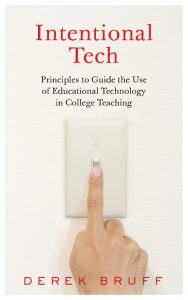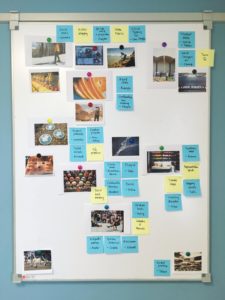Intentional Tech, Coming Fall 2019
 I am very excited to announce that my next book, Intentional Tech: Principles to Guide the Use of Educational Technology in College Teaching, will be published this fall by West Virginia University Press! The book is part of their “Teaching and Learning in Higher Education” series edited by James Lang and Derek Krissoff. I am thrilled to be a part of this series, joining fantastic scholars and authors like Sarah Rose Cavanagh, Thomas Tobin, and Joshua Eyler. And it’s been a joy to work with Jim and Derek and to benefit from their wisdom and guidance as this project went from proposal to paperback.
I am very excited to announce that my next book, Intentional Tech: Principles to Guide the Use of Educational Technology in College Teaching, will be published this fall by West Virginia University Press! The book is part of their “Teaching and Learning in Higher Education” series edited by James Lang and Derek Krissoff. I am thrilled to be a part of this series, joining fantastic scholars and authors like Sarah Rose Cavanagh, Thomas Tobin, and Joshua Eyler. And it’s been a joy to work with Jim and Derek and to benefit from their wisdom and guidance as this project went from proposal to paperback.
Back in 2017, when I decided to write my next book, I knew I wanted to work with James Lang, professor of English and director of the D’Amour Center for Teaching Excellence at Assumption College. Through his writing, including books like Cheating Lessons and Small Teaching and his columns for the Chronicle of Higher Education, Jim grounds research on teaching and learning in concrete classroom practices and stories that inspire and equip college faculty to teach well. That’s what I wanted to do with my book on teaching with technology, so I reached out to Jim with a pitch. He liked what he heard and asked me to work up a full proposal for WVU Press. I spent a good chunk of the summer of 2017 brainstorming and outlining and organizing, and writing a sample chapter. I submitted my proposal to Jim and to Derek Krissoff, director at West Virginia University Press, that fall, and was very pleased to get the green light.
Much writing ensued, followed by very helpful reviewer feedback, a fair amount of revisions and additions, and a surprisingly long conversation about book titles. I knew working with Jim would be rewarding; I didn’t know how much I would come to value Derek Krissoff’s experience and input along the way. He and his team at WVU Press are skilled professionals, and I know the book is in good hands as it moves through the final stages of the editing and publication process. We confirmed the cover this week, which is why I’m announcing the book now, and Intentional Tech should available for pre-order on the WVU Press website in a few weeks, with an October 1 street date. That feels like a long way off, but I know the wait will be worth it.
So what is Intentional Tech about? Here’s the catalog copy, to give you a sense:
Chalkboards and projectors are familiar tools for most college faculty, but when new technologies become available, instructors aren’t always sure how to integrate them into their teaching in meaningful ways. As faculty interested in supporting student learning survey the changing landscape of technology, determining what’s possible and what’s useful can be challenging.
Arguing that teaching and learning goals should drive instructors’ technology use, not the other way around, Intentional Tech explores seven research-based principles for matching technology to pedagogy. Through stories of creative and effective use of educational technology by faculty and other instructors, author Derek Bruff approaches technology not by asking “How to?” but by posing a more fundamental question: “Why?”
 Figuring out what those “seven research-based principles” would be occupied most of that brainstorming back in 2017. If you’ve seen me give talks and workshops, you know how much I like a good mind map, and that’s the tool I used to collect and sort and organize all the educational technology principles and practices I’ve been exploring over the last few years. It’s amazing to think that what was once just a mind map on the white board in my office will be an actual book to share with the higher education community in just a few months!
Figuring out what those “seven research-based principles” would be occupied most of that brainstorming back in 2017. If you’ve seen me give talks and workshops, you know how much I like a good mind map, and that’s the tool I used to collect and sort and organize all the educational technology principles and practices I’ve been exploring over the last few years. It’s amazing to think that what was once just a mind map on the white board in my office will be an actual book to share with the higher education community in just a few months!
Since that mind map is a little hard to read, and since the principles I landed on changed a little from that initial brainstorming, here is a list of the teaching principles I explore in the new book:
- Times for Telling – Giving students a hard problem or challenging experience can help them get ready for learning.
- Practice and Feedback – To learn new skills, students need practice applying those skills and feedback on that practice.
- Thin Slices of Learning – The more we understand what and how our students are learning, the more responsive we can be to their learning needs.
- Knowledge Organizations – Providing students with visual ways to organize their knowledge can help them remember and use that knowledge.
- Multimodal Assignments – When students work with new material using different kinds of media, they are better able to learn that material.
- Learning Communities – Structured ways for students to learn from and with each other can enhance the learning experience for all students.
- Authentic Audiences – Connecting students to authentic audiences for their work can motivate students toward deeper learning.
These principles are illustrated with stories and examples from the classrooms of more than three dozen faculty and graduate student instructors representing a range of disciplines and institutions. I am deeply grateful to all those who took time to talk with me for letting me share their stories in the book. They inspire me, and I know their stories will inspire others.
I’ll have more updates as we get closer to press!